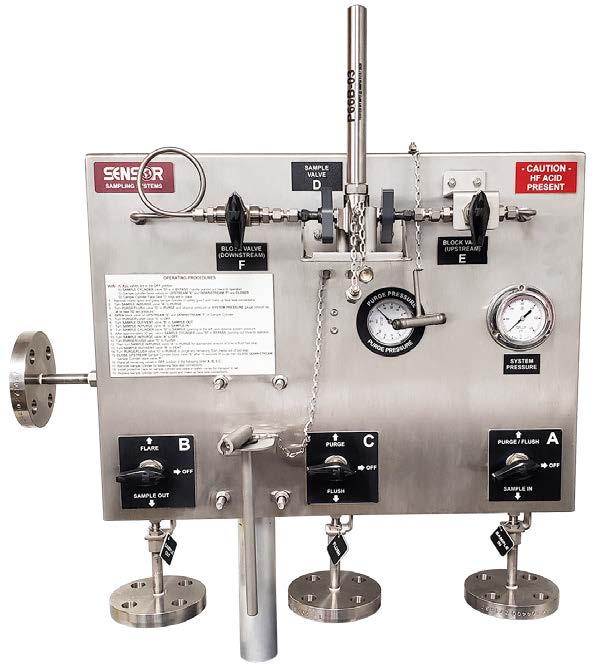Hydrofluoric (HF) acid is one of the most challenging and dangerous process media to sample. Not only does it require special materials of construction for corrosion resistance, but it is also incredibly toxic in small amounts and presents the potential for significant injury or worse. Collecting samples of HF acid requires a unique grab sampling system and professionals with a high degree of understanding on how to sample HF acid while maintaining safety in the alkylation unit.
1. How to obtain a good representative sample.
a. Take from a high-pressure point and return to a low-pressure point to ensure adequate flow so that the sample is representative.
b. Small amounts of sample (10-20g) are collected, so traditional sample cylinders cannot be used and instead requires a special collection assembly.
2. How to collect a good sample without exposure to the operator or a release to the atmosphere.
a. Neutralize and flush out the acid at the end-connection points of the collection assembly with isobutane to the process return line.
b. Purge isobutane to the acid flare, then flush with nitrogen before breaking the end-connection points and removing the collection assembly.
3. How to prevent waste to minimize environmental footprint.
a. The SENSOR Sampling design allows the HF acid to always flow through the collection assembly to the return line (or only during collection if desired).
b. Rather than sending residual HF acid to the acid flare, we utilize an isobutane flush to push residual HF back to the return line.
4. How to safely transport the sample from the field back to the lab.
a. The SENSOR Sampling collection assembly is provided with safety caps that are threaded over the ends of the connections to prevent exposure if the valve were to leak during transport.
b. We provide a sealed transport case for the collection assembly to contain any potential leaks. It has windows on both sides of the case so you can physically see the collection assembly. The windows are made of acrylic to prevent etching from the HF acid over time.
5. What the lab needs for a properly collected sample.
a. The lab will have already weighed the empty collection assembly before it goes out to the field.
b. Collection of the HF must be done right the first time, as this is probably the most dangerous sample collection done in a refinery, but also to minimize waste.
c. The SENSOR Sampling HF system lines up the sample to flow directly through the collection assembly to ensure the appropriate amount of sample is collected every time.
d. The connection assembly fits into the lab unloading system and lines up perfectly, so the lab isn’t trying to connect it manually or clamp it in place. Also includes an actuator to rotate the valve to the extract position which can be done remotely from outside the fume hood.
6. How to unload the sample in the lab to obtain desired moisture and purity results.
a. After returning to the lab, the collection assembly is weighed again to determine how much sample was collected in the field.
b. If not constrained by limited space under the fume hood, two lab unloading systems are recommended, with one being used for the moisture test and the other for the purity test.
c. We design the lab unloading system(s) to best serve your needs.
7 . Why the system needs to be designed so that you can not only collect a good sample but have a system that allows for proper cleaning and consistent operation.
a. The field collection system needs to be continuously available for collecting samples with zero downtime.
b. SENSOR Sampling Systems are specifically designed and constructed with materials that resist HF such as M400, PTFE seats, and Kalrez® o-rings.
c. The isobutane flush provides a means to remove residual HF from any connection points, and the nitrogen purge then cleans out the lines every time a sample is collected. This flush and purge leads to a cleaner system that extends the life of the system, while also making a clean break so there is no exposure to the operator.
d. We understand the importance of consistently obtaining a representSuppSupposeeive sample. If you do not consistently get a representative sample, it requires additional samples to be taken or a return to an outdated method of collecting, thereby creating more environmental waste and unsafe conditions for the operator.
Datasheet
Ready to find out more?
Drop us a line today for a free quote!





